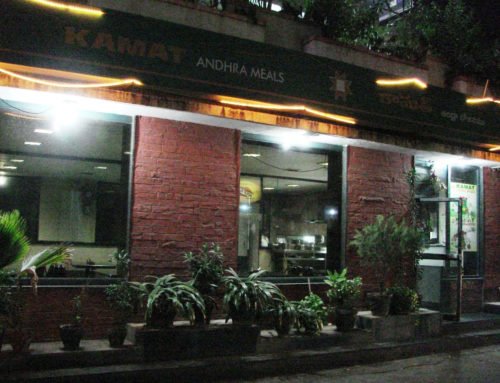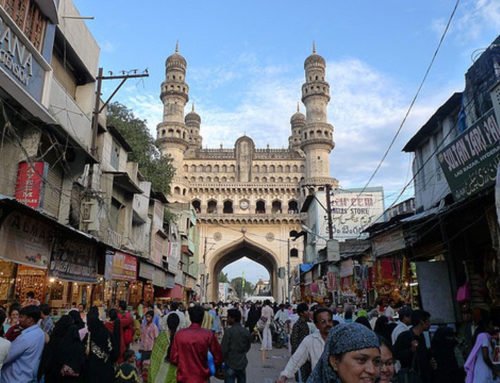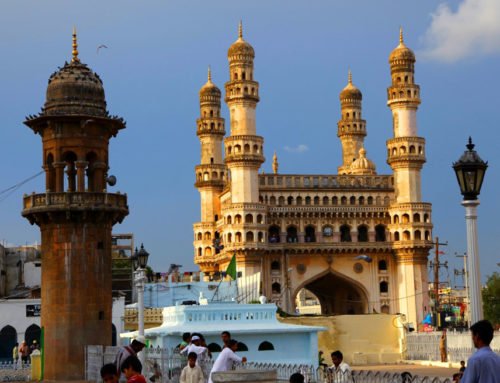Overview
- Features: Medieval fortress with royal apartments and halls, temples, mosques, magazines, and stables
- Opening Times: 9am to 5pm, daily
- Best Time to Visit: Late October to early March
- Duration: 2 to 3 hours
- Travelled By: Bus
- Cost: Indian/foreigner Rs 5/100
- Address: Golconda Fort, Hyderabad, Andhra Pradesh, India
- Type: Fort
Author Reviews[display_rating_item_results rating_form_id=”2″ rating_entry_ids=”1″ show_category_filter=”false” show_options=”true” result_type=”star_rating” preserve_max_rating=”true” show_title=”false” show_count=”false” ]
Total Rating: [display_rating_result rating_form_id=”2″ show_count=”false” show_rich_snippets=true] [accordions load=”1″] [accordion title=”User Reviews” last] [display_rating_item_results rating_form_id=”5″ show_options=”true” result_type=”star_rating” preserve_max_rating=”true” show_title=”false” show_count=”true” show_rich_snippets=true] [/accordion] [accordion title=”Add Review”][display_rating_form show_email_input=”true” show_comment_textarea=”true” show_name_input=”true” rating_form_id=”5″] [/accordion] [/accordions]
Summary
The spectacular Golconda Fort near Hyderabad is not just a historical attraction; it also hides secrets from its past. A visit to this fort will allow you to uncover some of these hidden secrets, but you must know what they are and where to look for them. As you read through the post you will uncover some of these secrets and understand the mystery behind the famous Golconda Fort. Look for the word ‘Secret’.
Secrets of Golconda Fort Hyderabad
Frequently Asked Questions About Golconda Fort
Below are the answers to some frequently asked questions about Golconda Fort.
Who Built Golconda Fort?
The Golconda Fort was built out of a mud fort that was originally created by the Yadavas and Kakatiyas around the 12th-century. It was transformed into a splendid fortified city of grand palaces, mosques and gardens by successive Qutb Shahi rulers.
When was Golconda Fort Built?
The Golconda Fort was transformed from a mud fort into the splendid fort it is today between 1518 and 1580.
Where is Golconda Fort Located?
Golconda Fort is located in Golconda, on the outskirts of Hyderabad in Andhra Pradesh, India.
How to Reach Golconda Fort?
There are several transportation options to get from Hyderabad to Golconda Fort.
The most convenient way to Golconda Fort is in an autorickshaw from Hyderabad. However, the most affordable way to get here is on a one-hour bus journey either with Bus 119 from Nampally station or Bus 66G from Charminar. It is also possible to hire a private car with chauffeur from a reputable hotel or travel agency in town.
Golconda Fort Map
Golconda Fort History
[singlepic id=1861 w=720 h=560 float=center]
Sprawling across a boulder-strewn plateau, Golconda (“Shepherd’s Hill”) Fort was the citadel of the Qutb Shahi dynasty which ruled the Hyderabad region from 1507 to 1687. The earlier 12th-century mud fort that stood here has been traced to the earlier reigns of the Yadavas and Kakatiyas. It was transformed between 1518 and 1580 into a splendid fortified city of grand palaces, mosques and gardens by successive Qutb Shahi rulers. Golconda Fort was also famous for its great hoard of diamonds, mined nearby, which included the celebrated Kohinoor diamond, now part of the British crown jewels. The colossal ruins of Golconda cover an area of 40 sq km (15 sq mil).
This great fortress is protected by three formidable lines of defence. The first, an outer fortification made of enormous blocks of grantite, encircles the citadel and its entire township. The middle wall surrounds the base of the hill, while the innermost one follows the contours of the highest ridge.
[singlepic id=1844 w=720 h=560 float=center]
The citadel’s 10-km double wall had 87 bastions with cannons, four drawbridges and eight huge gateways with outer and inner doors and guardrooms between. Some of the guns of the Qutb Shahis are still there with fortifications at various levels on the way up. Secret #1 Another of India’s supposed underground tunnels is believed by some to run for about 8 km from a corner of the summit to Gosha Mahal. The fort had an ingenious system of laminated clay pipes and huge Persian Wheels to carry water to cool the palace chambers up to the height of 61 m where there were hanging gardens. Secret #2 The famous diamond vault located in the fort once held the Koh-i-noor and Hope diamonds. The fort fell to Emperor Aurangzeb after two attempts, an eight-month siege and the help of a Qutb general-turned-traitor. English traveller Walter Hamilton described it as being almost deserted in 1820: “the dungeons being used by the Nizam of Hyderabad as a prison for his worst enemies, among whom were several of his sons and two of his wives”.
Detailed Information About Golconda Fort
Visitors enter through the Fateh Darwaza (“Victory Gate”) on the east side, which has a Hindu deity carved above its arch. Huge iron spikes are studded into the gate to prevent it from being stormed by elephant cavalries.
From the Fateh Darwaza, the road curves past the Archaeological Museum (the old Treasury), and through the bazaar, once a famous centre for cutting and polishing diamonds. Beyond are the two massive arches of the Habshi Kaman Gate, with rooms on top. These used to house a drummers’ gallery and the sultans’ Abyssinian guards. This gate leads to the middle fortification wall.
[singlepic id=1850 w=720 h=560 float=center]
To its north is the austere domed Jami Masjid, built in 1518 by Sultan Quli Qutb Shah, the founder of the dynasty; he was murdered here while at prayer by his son Jamshed in 1543. Beyond is the ceremonial arch, the Bala Hisar Gate, decorated with various Hindu motifs, including yalis (fantastic leonine beasts). This is the entrance to the inner citadel, known as the Bala Hisar Complex, where the royal palaces, assembly halls, workshops and an armoury are located. It has a pointed arch bordered by rows of scroll work. The spandrels have yalis and decorated roundels. The area above the door has peacocks with ornate tails flanking an ornamental arched niche. The granite block lintel below has sculpted yalis flanking a disc. The design of peacocks and lions is a blend of Hindu – Muslim architecture.
[singlepic id=1859 w=720 h=560 float=center]
North of the Bala Hisar is a walled enclosure, begun in 1652, and planned as an extension to the inner fort. Hathion ka Jhaad (“Elephant Tree”), in the Naya Qila, is an extraordinary 700-year-old Baobab tree (Adansonia digitata) with a circumference of 25m said to have been brought to Golconda by the sultans’ Abyssinian guards.
[singlepic id=1860 w=720 h=560 float=center]
Survival within the fort was also attributable to water and sound. Secret #3 A series of concealed glazed earthen pipes ensured a reliable water supply, while the ingenious design of the large-domed Grand Portico behind the Bala Hisar Gate creates a superb acoustic system that enabled a drum beat, bugle call or even a clap under the canopy of this gate to be heard by someone at the very top of the palace – used as a security system; it is put to test by the visiting crowds today. Guides can also demonstrate the equally impressive acoustics in the royal palace where one’s whisper into the corner of the wall can be heard perfectly through the walls in the opposing corner, designed to catch out conspirators.
[singlepic id=1853 w=720 h=560 float=center]
Inside the gate is the Nagina Bagh which means “Jewel among the Gardens”. It was designed after the typical Mughal Gardens and has a square layout divided into quadrants by paved pathways converging into a fountain located at the centre of the gardens.
[singlepic id=1854 w=720 h=560 float=center]
Beyond the gate the Mortuary Bath on the right has beautiful arches and a crypt-like ceiling. This structure was built in the style of Persian and Turkish baths and was used for the ceremonial bathing of the dead body of the royal family. It has separate cisterns for hot and cold water flowing through concealed terracotta conduits for ensuring regular water supply.
[singlepic id=1847 w=720 h=560 float=center]
Here you can also see the remains of the three-storey armoury and the women’s palaces on the left.
Aslah Khana is one of the imposing structures of Bala Hissar and was used as a fire arms depot. This three-storied structure consists of rows of arches in each floor marked by a long hall.
[singlepic id=1846 w=720 h=560 float=center]
[singlepic id=1842 w=720 h=560 float=center]
About halfway up is a large water tank or well and to the north is what was once the most densely populated part of the city. Nearby, the domed storehouse turned into the Ramdas Jail and has steps inside that lead up to a platform where there are relief sculptures of deities on the wall, dominated by Hanuman.
[singlepic id=1852 w=720 h=560 float=center]
The Ambar Khana (royal granary) has a Persian inscription on black basalt stating that it was built by Khairat Khan between 1626 and 1672 during the reign of Abdullah Qutb Shah.
The steps turn around an enormous boulder with a bastion and lead to the top passing the graceful Ibrahim Mosque built by Sultan Ibrahim Qutb Shah, the third sultan, and the ancient Hindu Mahakali Temple, built into a cave.
[singlepic id=1862 w=720 h=560 float=center]
[singlepic id=1858 w=720 h=560 float=center]
Ibrahim Mosque is a good example of Qutb Shahi architecture. This simple yet beautiful mosque is marked by three arches with the central being larger than the flanking smaller arches on it’s either sides. At the base it has nine small arches. The external stucco decorations represent typical Qutb Shahi art style.
[singlepic id=1857 w=720 h=560 float=center]
At the summit of the hill is the three-storeyed breezy Durbar Hall (“Throne Room”), with a rooftop pavilion. The lower two stories are called Diwan-i-Khas and Diwan-i-Am which were the private and public audience halls.
[singlepic id=1849 w=720 h=560 float=center]
[singlepic id=1843 w=720 h=560 float=center]
From here there are wonderful views of the entire fort and its surroundings, which include two pretty structures on hillocks – Taramati Baradari and Premamati’s Mosque. These are named after the two dancers who were royal favourites, and said to be so lightfooted that they could dance all the way from the pavilion to the Bala Hisar on a tightrope.
[singlepic id=1851 w=720 h=560 float=center]
The path down is clearly signposted to take you on a circular route through the harem and the ruins of the Qutb Shahi palaces with its royal baths, back to the main gate. The most impressive of these palaces is the Rani Mahal, a vaulted hall on a raised terrace, decorated with lovely floral arabesques. Hollows in these carvings were once inlaid with Golconda’s famous diamonds and other precious stones. A welcome chilled drink and snack is available at several cafés opposite the gate.
Standing outside the Golconda fort, east of the Fateh Darwaza, is the Nau Mahal (“Nine Palaces”), where the Nizam of Hyderabad held court whenever they came of Golconda.
Golconda Fort Sound and Light Show
A colourful sound-and-light show is held at Golconda Fort in English at 6.30 pm in winter (between November and February) or 7 pm in summer (between March and October).
Knowledgeable guides (1½hr tour Rs600) are organised through the AP Tourism table in front of the entrance. Small guidebooks to the fort are also available.
Golconda Fort Timings
Golconda Fort is open daily between 9 am and 5:30 pm. Expect to spend 2 to 3 hours exploring the grounds of this fort.
Golconda Fort Entry Fee
The entry fee for Golconda Fort is Rs 5 for Indians and Rs 100 for foreigners. There are no extra fees for still or video cameras.
Golconda Fort Address
Ibrahim Bagh,
Hyderabad,
Telangana,
Andhra Pradesh,
India
Golconda Fort Contact Number
+91 40 2351 2401
Tell us what you think. Are there any other secrets that you know about Golconda Fort?
We love to hear from you so please leave your comments below.








The entry fee for Indians and out side India people can be increased , so that the maintenance and staff can be increased for better security.
Hope there should be some nominal fee to be charged for Cameras/ Videos.
Thank you.
I m a tourist from State-Bahawalpur.
I’m crazy about History.your web provided a comprehensive description about The Fort.
One Suggestion More pix should be there withe each description.
I wish to visit ans feel its glory live.